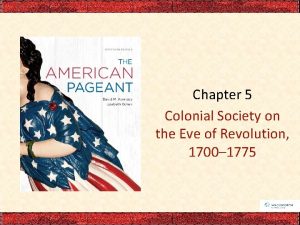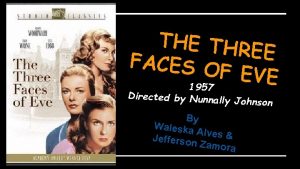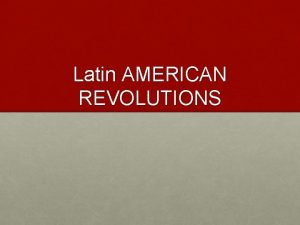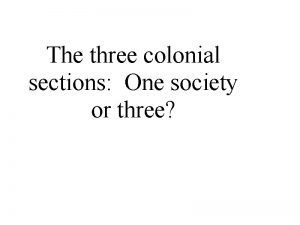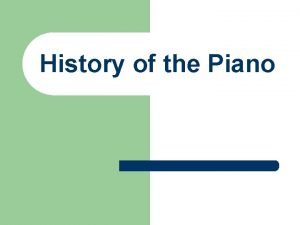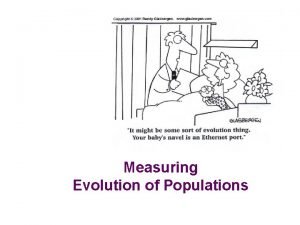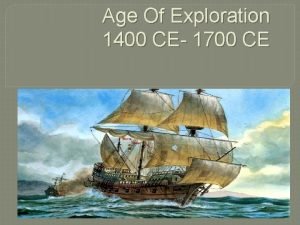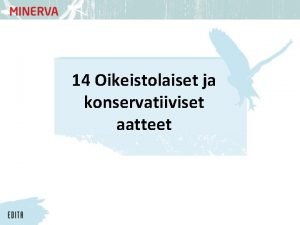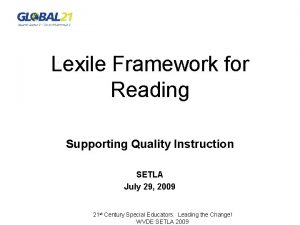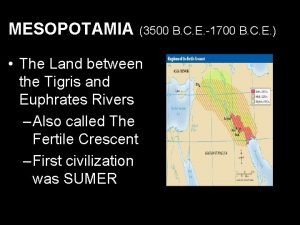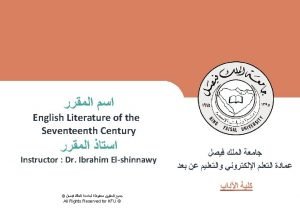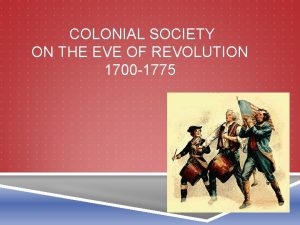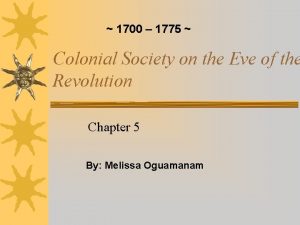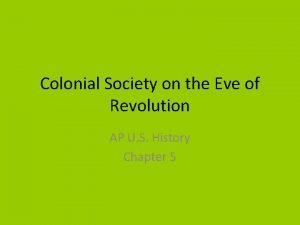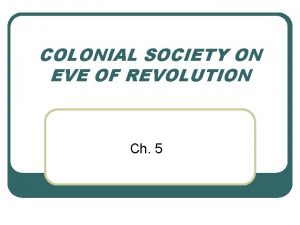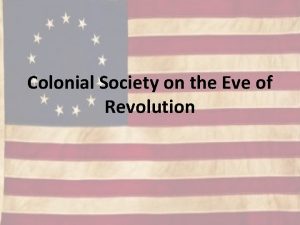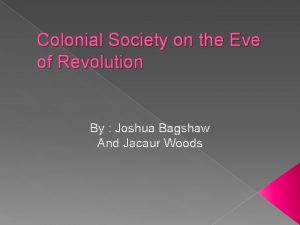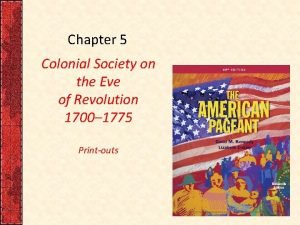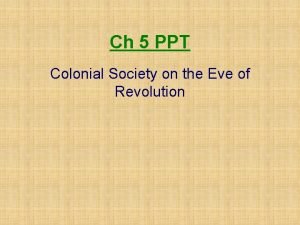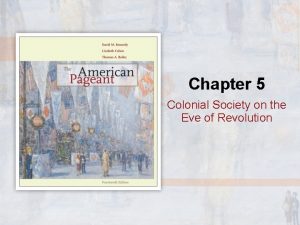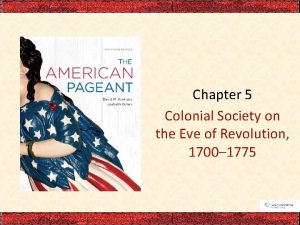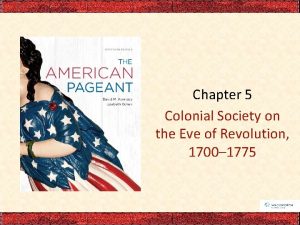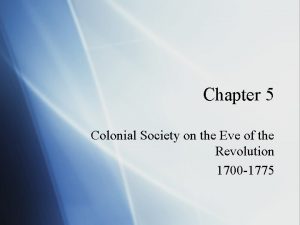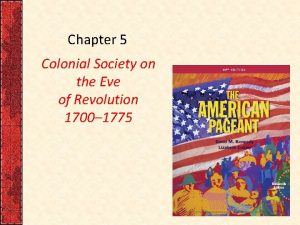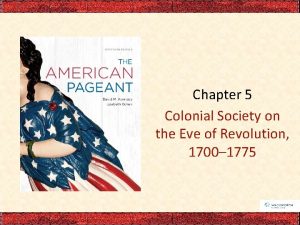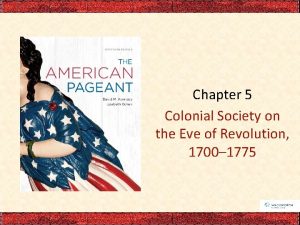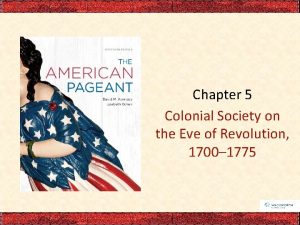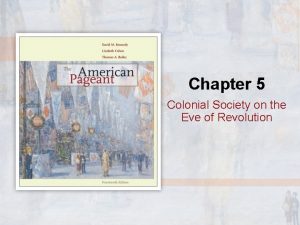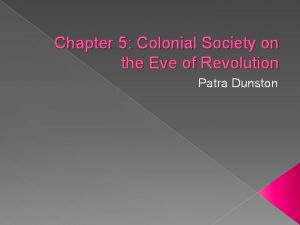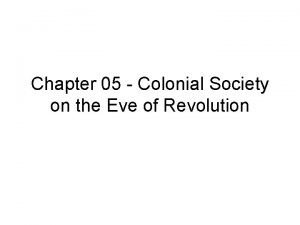Colonial Society on the Eve of Revolution 1700
























- Slides: 24

Colonial Society on the Eve of Revolution 1700 -1775

Conquest by the Cradle • By 1775 Britain ruled 32 colonies (Canada, Florida, Caribbean) • The “rebellious colonies” (13 colonies) had one outstanding common feature: their populations were exploding • 1700 -less than 300, 000/20, 000 -black; 1775 2. 5 million/1/2 -black • Most of the increase came from natural fertility

• Youthful generationaverage about 16 • American born colonists were growing, thus weakening British authority • Most populous: Virginia, Massachusetts, Pennsylvania, North Carolina, and Maryland (in order) • Most lived east of the Alleghenies • 90% lived in rural areas

A Mingling of the Races • Colonial America was a “melting pot” • Germans of Pennsylvania-primarily Lutheran erroneously called Pennsylvania Dutch • Germans moved into the backcountry of Pennsylvania; able to buy land; farmers; and was not loyal to the British crown • Scotch-Irish-they were not Irish but Scots Lowlanders. They had been transplanted to Northern Ireland. The Irish Catholics did not like the Scottish Presbyterians • 1700’s tens of thousands of Scots. Irish settled in the backcountries from Pennsylvania to Georgia. Being used to conflict in Ireland, they did not mix well with the Indians

• Whiskey distilling became abundant in the Appalachian hills • They did not like the English nor any government • Paxton Boys -march on Philadelphia in 1764 protesting the Quaker’s lenient policy toward the Indians • Regulator Led the Regulator movement in North Carolinaan insurrection against eastern domination of the colony’s affairs. • Andrew Jackson was a descendent of the Scotch-Irish

• 5% were non English groups: French Huguenots, Welsh, Dutch, Swedes, Jews, Irish, Swiss, Scots Highlanders, Scots. Irish-These, except for the Scots Highlanders, felt little loyalty to England • 20% of the population were Africans • Mainly Anglo-Saxon-most diverse in the world • New England was the least ethnic diverse • Pennsylvania had the most diverse culture • Outside of New England ½ of the population was non English by 1775 • A new American multicultural identity emerged

The Structure of Colonial Society • 18 th Century America was a land of equality and opportunity except slaves • No titled nobility; no very poor underclass; most were small farmers • The most remarkable feature of the social ladder was the “rags-toriches” ease in which one could rise • Wars of the 1690’s and early 1700’s did enrich a number of merchant princes in New England the middle colonies. They made fortunes with the profits made by being military suppliers. • Wars caused widows which received help in both Philadelphia and New York “almshouses” (social charities) • Land ownership declined in New England as the population grew almshouses

• Southern aristocrat prosperity widened the gap between the wealthy and the “poor whites” • Indentured servants could achieve prosperity after their servitude • Paupers and convicts involuntarily shipped to America “jayle birds” were much less fortunate • Black slaves were the most unfortunate. Fears of Black rebellion plagued the white colonists • Many colonies did not want the slave trade since rebellion could break out. England would overrule laws hindering the slave trade. Indentured servants

Clerics, Physicians, and Jurists • Most honored of the professions was the Christian ministry • Physicians were not highly esteemed (poorly trained) • Plagues of the 1700’s reminded the colonists of their mortality. This was a breeding ground for the religious revivals soon to come • By 1750, attorneys were becoming recognized as a valued profession

Workaday America • Agriculture was the leading industry-90% of the people • Tobacco main staple crop in Maryland Virginia • Middle colonies “bread basket” produced large quantities of grain • Americans probably enjoyed a higher standard of living than the masses of any country in history up to that time • New England Colonies: fishing, lumber, small farms • Middle Colonies: grain, cattle • Chesapeake Colonies and North Carolina: tobacco; the other Southern colonies grew rice and indigo • Cotton had not yet emerged as a major crop

• Triangular Trade: New England produced rum; the rum was taken to Africa and sold for African slaves; the African slaves were taken to the West Indies and sold for molasses; the molasses was taken to New England turned into rum. • Rum was made in large quantities in Rhode Island Massachusetts • Pennsylvania produced iron (Valley Forge) • Manufacturing was limited: lumber was the most important single manufacturing activity • Productivity exceeded British abilities to purchase products. Colonies looked to other countries for commerce • The Molasses Act was aimed at stemming North American trade with the West Indies

Horsepower and Sail Power • Transportation by road was very bad • Travel by boat was much faster and communities became established by rivers • Taverns grew as a result of travel. Taverns became forerunners to American Democratic ideals.

Dominant Denominations • Two “established, ” or taxsupported churches were operating in America by 1775: the Anglican (Church of England) and the Congregational (Puritan). • Anglican: Georgia, North and South Carolina, Virginia, Maryland, and part of New York-less fierce and more worldly than New England. William and Mary College was established to train a better class of clerics • Congregational: all New England colonies except Rhode Island • Religious tolerance for the most part; Roman Catholics generally discriminated against (not numerous). In general, by the 18 th century (1700’s) most could worship or not worship as they pleased • Middle Colonies: no established church

The Great Awakening • Liberal religious ideas were challenging old-time doctrine. Arminianism taught that individual free will, not divine decree, determined a person’s eternal state. • The stage was set for a religious revival-this was known as the “Great Awakening” • 1730’s-1740’s. Massachusetts. Jonathan Edwards-Sinners in the Hands of an Angry God • George Whitefield-revival meetings; human helplessness and divine omnipotence George Whitefield

• Lasting effects: undermined the “old clergy” as being the only authoritative source; many denominations were established; missionary work among Indians and black slaves; led to “new light” centers of higher learning (Princeton, Brown, Dartmouth); • The most significant effect: It broke down sectional boundaries and denominational lines and contributed to the growing sense that Americans were a single people united by a common history and shared experiences • If colonists could receive divine instruction and salvation “freely” then they should also receive civil and political laws “freely. ” Jonathan Edwards

Schools and Colleges • New England promoted education-Bible reading. Education was primarily for boys. Schools were tax supported • Middle Colonies: some tax supported schools; some privately operated; some private tutors • Latin, Greek, independent thinking was discouraged; discipline was severe • By 1750 schools moved toward “live” languages and more modern subjects; • Benjamin Franklin-University of Pennsylvania-first American college free from denominational control

Culture in the Backwoods • Americans took little time for the arts • Artists: John Trumbull of Connecticut (1756 -1843) famous for Revolutionary War paintings; Charles Wilson Peale (1741 -1827) portraits of George Washington • Literature was not promoted well • Benjamin Franklin Poor Richard’s Almanack more widely read in America than any work except the Bible • Science was surpassing superstitions

Pioneer Presses • Benjamin Franklin established in Philadelphia the first privately supported circulating library in America by 1776 • Newspapers were a powerful agency for grievances any rallying oppositions to British control • Zenger Case-John Peter Zenger newspaper printer in New Yorkexposed the corrupt royal governor. Charged with libel. Andrew Hamilton stated that “the very liberty of both exposing and opposing arbitrary power” was at stake. Zenger acquitted-led to freedom of the press. • This case led to the doctrine that true statements about public officials could not be prosecuted as libel.

The Great Game of Politics • By 1775 all the colonies: royal colony; proprietor colony; self governing – Royal: (8) Massachusetts, New York, New Hampshire; New Jersey; Virginia; North and South Carolina; Georgia. King chose the governor – Proprietary colonies: (3) Maryland, Pennsylvania, Delaware-the proprietors chose the governors – Self-governing charters: (2) Connecticut and Rhode Island-elected their own governors

– Most all colonies utilized a twohouse legislative body • Lower house-elected by the people (property holders) • Upper house-appointed by the crown in the royal colonies and by the proprietor. It was chosen by the people in selfgoverning colonies • Backcountry colonists were seriously underrepresented • Taxes were voted by the legislatures-Self-taxation through representation was the mainstay of the colonies

• Royal officials had difficulty controlling the colonial legislatures-3, 000 miles away • Colonial legislators controlled the “purse” • County governments remained the rule in the Southern colonies • Town-meetings prevailed as the main government in New England • A modification of county governments and town-meetings developed in the Middle Colonies • Direct democracy (everyone votes who can vote) worked best in the town meetings

• American colonists valued their privileges and exercised their duties as citizens of the New World commonwealths • Voting rights was determined by property qualifications; office holding had stiffer qualifications; privileged upper classes were fearful of democratic practices for all colonists; land was rather easy to attain so voting rights were acquired more readily • By 1775 America was still not a true Democracy: Socially politically, and economically

Colonial Folkways • Food was plentiful • Drafty homes were poorly heated • Amusement was eagerly pursued when time permitted • Lotteries, sports, stage plays, holidays, Christmas was frowned upon in New England, Thanksgiving came to be a truly American festival

• Colonial similarities: English in language and custom, Protestant in religion, some degree of ethnic and religious toleration, social mobility, self-government, communication and transportation were improving. • The colonies looked like a patchwork quilt-each part slightly different, but stitched together by common origins, common ways of life, and by common beliefs in toleration, economic development and above all-self-rule. • This led to the eventual uniting of the 13 American colonies
 Colonial society on the eve of revolution
Colonial society on the eve of revolution Colonial society on the eve of revolution
Colonial society on the eve of revolution Chapter 5 colonial society on the eve of revolution
Chapter 5 colonial society on the eve of revolution Eve white, eve black y jane
Eve white, eve black y jane The divisions in spanish colonial society 1789
The divisions in spanish colonial society 1789 The three colonial sections-one society or three
The three colonial sections-one society or three Nfpa 1700
Nfpa 1700 1700 bce
1700 bce Esapideak zerrenda
Esapideak zerrenda 1700/1600
1700/1600 Piano 1709
Piano 1709 Rivoluzione agricola 1700
Rivoluzione agricola 1700 Defines the request mast policy for marines
Defines the request mast policy for marines Mechanisms of evolution
Mechanisms of evolution Christopher columbus significance
Christopher columbus significance Rotazione quadriennale 1700
Rotazione quadriennale 1700 1700 luvun aatesuunta
1700 luvun aatesuunta Lexile score calculator
Lexile score calculator Cisco mobility express 設定
Cisco mobility express 設定 Dynastic cycle def
Dynastic cycle def Jacobean and caroline prose
Jacobean and caroline prose Russian revolution vs french revolution
Russian revolution vs french revolution You should hope that this game will be over soon
You should hope that this game will be over soon The third agricultural revolution
The third agricultural revolution How was french society divided
How was french society divided


